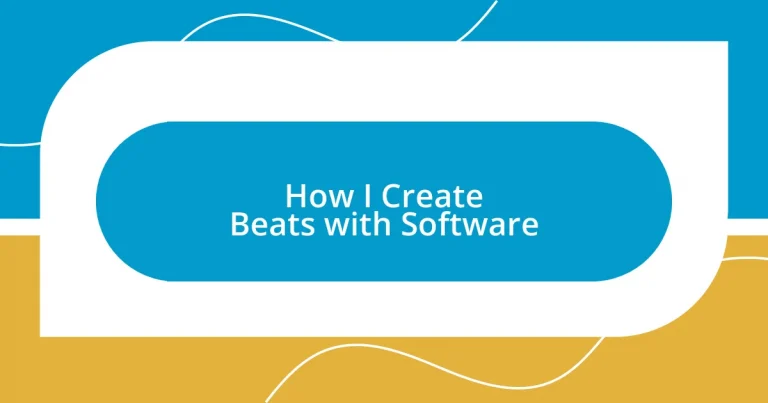Key takeaways:
- Choosing the right software is essential for beat-making; it should feel intuitive and fit your creative style while considering budget and features.
- Understanding basic beat structure involves mastering kick drums, layering elements like snares and hi-hats, and creating dynamic patterns to enhance the overall feel.
- Continuous improvement as a music producer requires seeking feedback, tracking progress, and being open to learning through experimentation and collaboration.
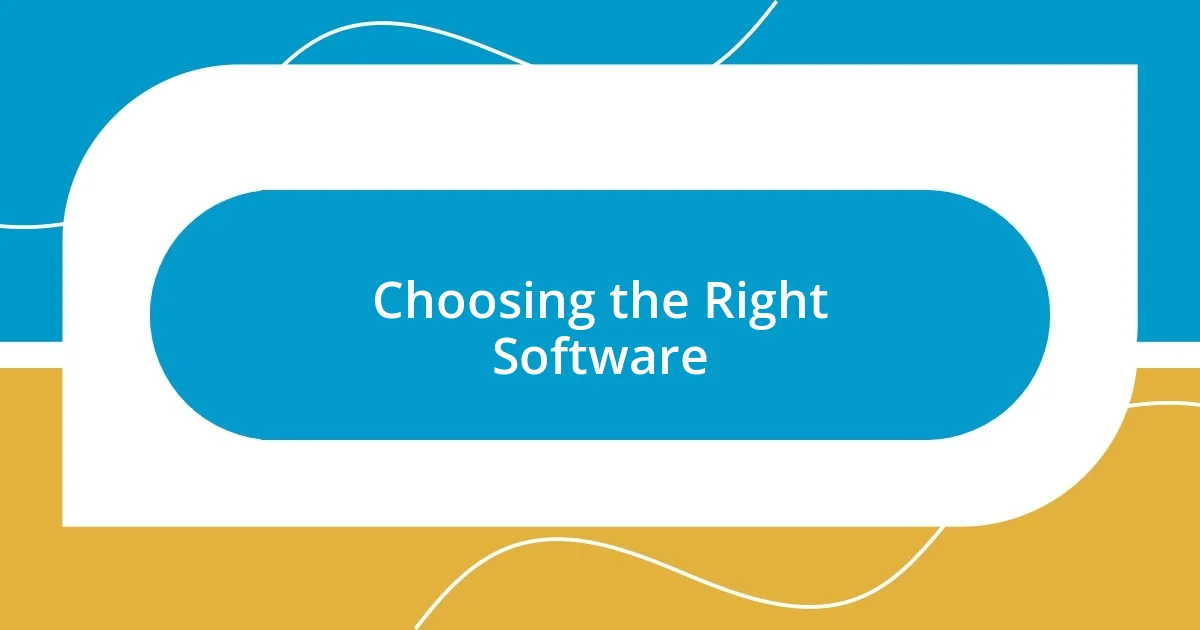
Choosing the Right Software
When it comes to choosing the right software for beat-making, I always emphasize the importance of finding a platform that feels intuitive to you. I can still remember the first time I downloaded a digital audio workstation (DAW) — it was overwhelming! I spent hours just clicking around, but once I found my groove, it felt like I unlocked a new part of my creative self.
Consider what features are most important to you. Do you need a vast library of sounds, or are you more focused on advanced editing capabilities? Personally, I gravitate towards software that allows for a seamless blend of samples and synths. I find that experimenting with various programs reveals which ones spark my creativity and keep me engaged.
It’s also crucial to think about your budget. Many high-quality options are available at different price points, and some even offer free versions. I often tell aspiring producers that it’s not just about the software; it’s about how you use it. Remember, the best choice is one that fits your unique style and helps you express your musical ideas freely. What has your experience been with different software?
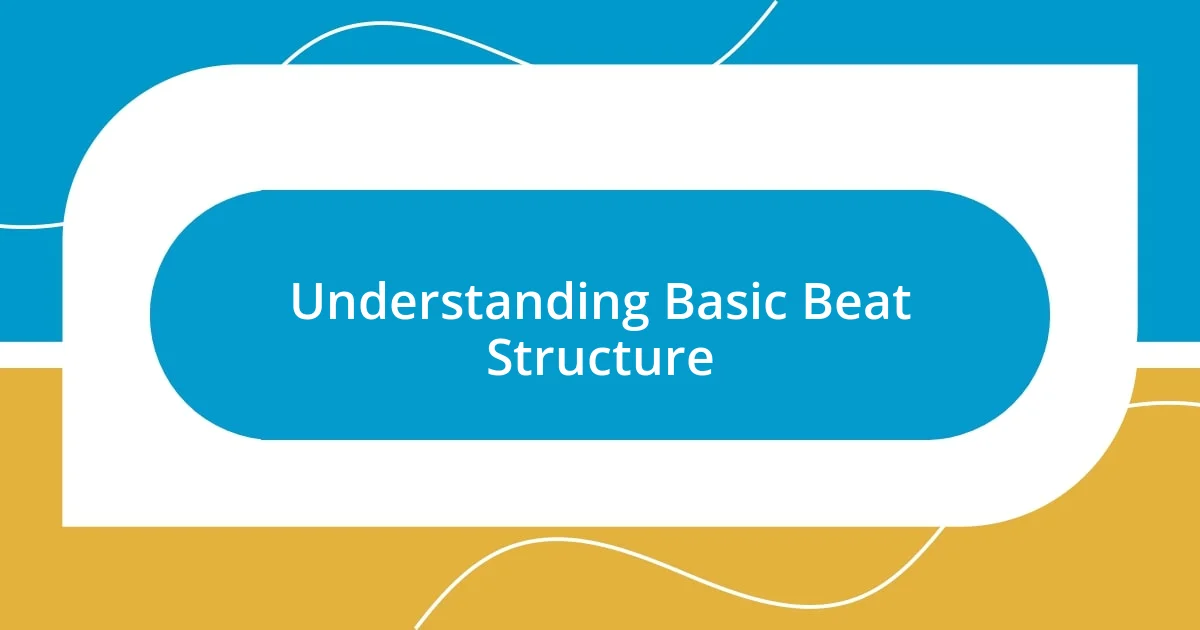
Understanding Basic Beat Structure
Understanding basic beat structure is essential for any aspiring producer. I often think of a beat like a house; it has a foundation and walls to give it shape. The kick drum lays the groundwork, setting the tempo and driving the rhythm. When I first started making beats, I would spend countless hours trying to find the perfect kick sound because I realized that the right foundation is everything.
As my skills developed, I learned the significance of layering. The snare or clap typically sits on the second and fourth beats, adding punch to the rhythm. This layering creates depth and texture, transforming a simple pattern into something more dynamic. I remember the excitement I felt when I adjusted my layers and suddenly heard a rich, full beat emerge—there’s something magical about that moment.
Finally, adding hi-hats and other percussion elements can help fill in the gaps. Hi-hats often provide that extra bounce, and experimenting with different patterns can drastically change the feel of your beat. I often play around with open and closed hi-hats to create movement within my tracks. It’s fascinating how such small details can elevate the overall vibe of a beat.
| Element | Function |
|---|---|
| Kick Drum | Provides the foundation and sets the tempo |
| Snare/Clap | Adds punch and helps define the rhythm |
| Hi-Hat | Fills in the gaps and creates movement |
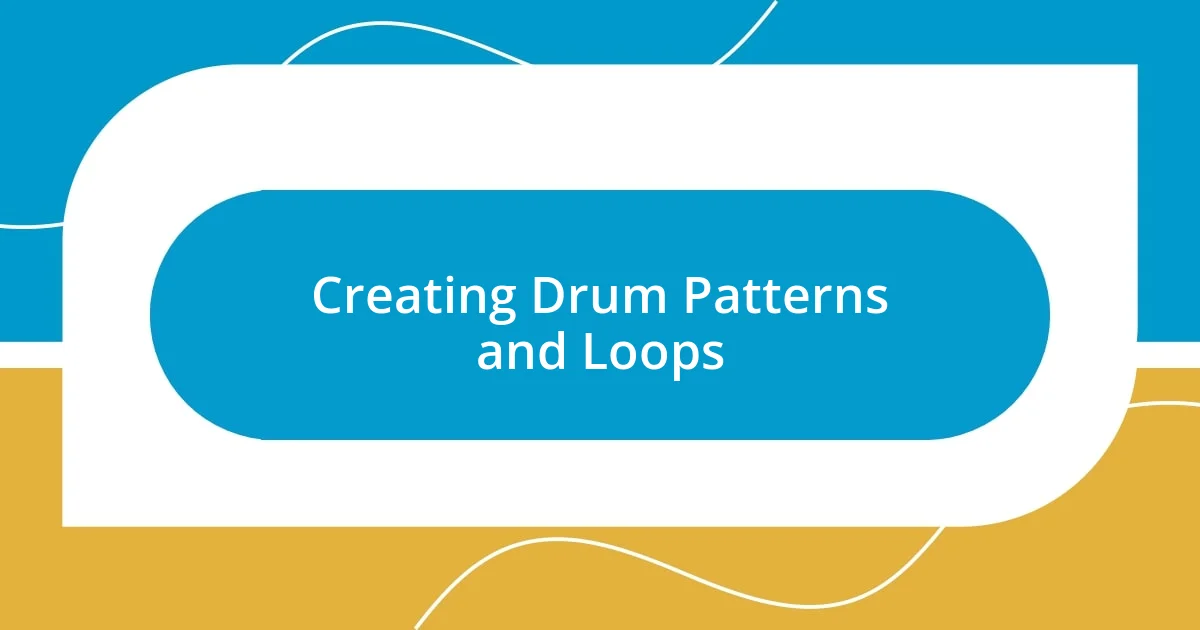
Creating Drum Patterns and Loops
Creating interesting drum patterns and loops is one of the most satisfying parts of beat-making for me. I remember my first attempts at programming a drum loop—I was discovering how different sounds interacted. It felt like I was unraveling a mystery. Building layers with various percussive sounds took my beats from ordinary to extraordinary. What I often do is trial different rhythms by simply manipulating the grid in my DAW, sometimes spending hours just adjusting the velocity of each hit to give it a more human feel. It’s this subtle detailing that breathes life into what can initially feel like a sterile grid of beats.
When I construct drum patterns, I pay close attention to the groove. Groove is what makes people nod their heads! Here’s a simple process I follow:
- Start with the kick: Lay down your foundational kick drum to establish a steady groove.
- Add a snare or clap: Place it on the 2 and 4 counts; this provides that snappy contrast to the kick.
- Incorporate hi-hats: Experiment with patterns—open and closed hi-hats can create varied feels.
- Layer percussion: Add shakers or other percussion elements to enhance rhythm and texture.
- Use swing: Emphasizing certain notes can introduce a danceable feel to your loop.
I can’t stress enough how experimenting with different elements changed my approach to drum patterns. Getting a bit lost in my DAW, tweaking sounds and patterns, often leads to unexpected creative breakthroughs.

Adding Melodies and Harmonies
Adding melodies and harmonies to my beats is where the real magic happens. I often start by playing around with different synths or virtual instruments to find a sound that resonates with me. It’s like painting a picture; I’ll experiment with various notes and chords until I feel that emotional spark. I remember the first time I stumbled upon a catchy melody—it just popped into my head while I was fiddling with a piano sound. That moment of inspiration left me buzzing for days!
Creating harmonies is equally fulfilling; they add depth and richness to a track. I sometimes layer simple melodies in thirds or fifths, which creates a fuller sound. The other day, I layered a soft pad under a lead melody, and the result was breathtaking—it transformed the entire vibe of my beat. When you blend harmonies, it’s like inviting other voices to join the conversation, making the music feel more alive. Have you ever noticed how a subtle change in harmony can evoke such different emotions?
Finally, don’t shy away from using variations in your melodies. I’ve learned that repeating a phrase but altering it slightly can keep things fresh. For instance, I often tweak a melody by changing a note or adding a rhythmic variation. This technique not only maintains listener interest but also creates a sense of progression within the track. It’s all about that delicate balance—knowing when to introduce new elements and when to let the existing ones shine. It’s a wonderful puzzle, and every new beat is an opportunity to explore!
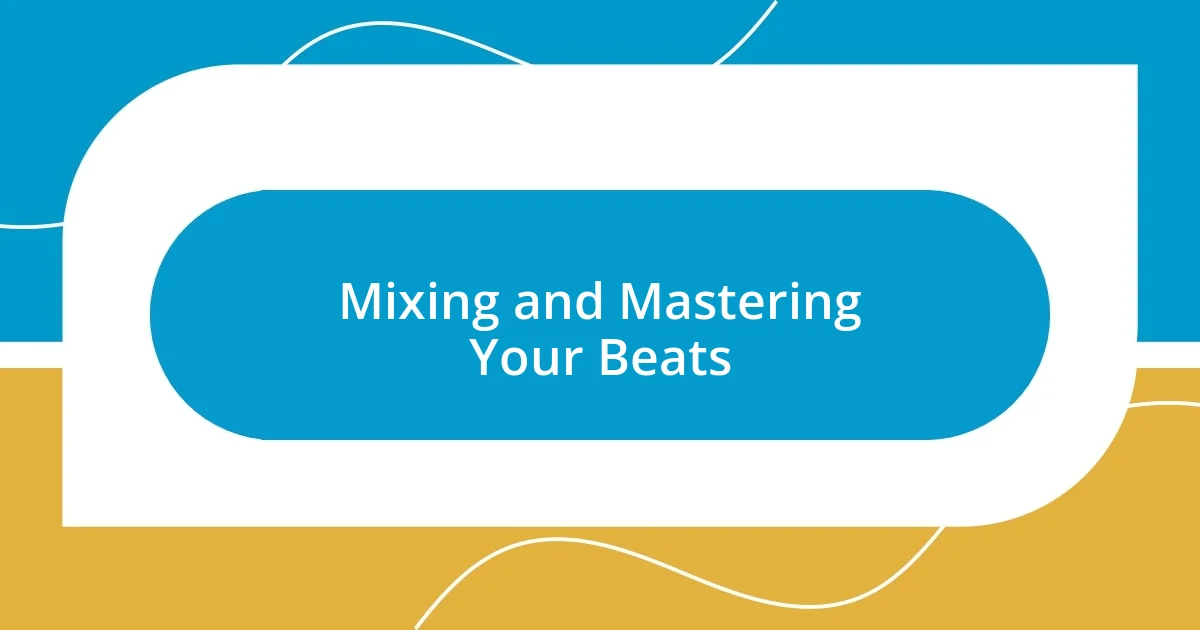
Mixing and Mastering Your Beats
Mixing and mastering your beats is a crucial step that can truly elevate your music. I remember the first time I mixed a track and felt a wave of excitement as I balanced the different elements. There’s something incredible about adjusting the levels, panning sounds from left to right, and tweaking EQ settings to find that sweet spot. It’s like solving a beautiful puzzle where each piece enhances the entire picture—have you ever experienced that moment when everything clicks into place?
When it comes to mastering, I’ve found it’s all about adding that final polish which makes your beat pop in a way that truly resonates with listeners. I often use a limiter to ensure the track’s volume stands strong against others. The first time I applied that technique, my beat transformed from a private creation to something that could compete on streaming platforms. It’s fascinating how that last touch can make all the difference between a rough gem and a polished masterpiece, isn’t it?
One tip I swear by is to take breaks between mixing sessions. I’ve burned out before, losing perspective on my work; stepping away can be a game changer. After a short break, you can return with fresh ears, noticing aspects that need more attention. It’s a simple practice, but it’s helped me refine my beats over and over again. How do you maintain your creativity during long sessions? It’s all part of the journey, and learning these strategies can lead to better outcomes for your tracks!

Exporting and Sharing Your Music
Exporting your music is akin to opening the door to the world. When I first discovered the process, I felt a rush of excitement and nerves. I remember I meticulously selected my best mix and hit the “export” button, and in that moment, my track transformed from notes on a screen to an accessible piece of art ready for others to experience. It’s thrilling to see my hard work captured in a file format, ready to be shared with friends, fans, and the wider audience.
Sharing your music can be equally exhilarating and daunting. I once posted a beat online and was flooded with both support and constructive criticism—it was a whirlwind of emotions! Platforms like SoundCloud or Bandcamp can amplify your reach, allowing you to connect with listeners who vibe with your style. Have you ever felt that spark of connection when someone resonates with your sound? It’s one of the most fulfilling parts of being a musician in today’s digital age, knowing your work can touch lives across the globe.
Remember, quality matters when sharing your music. I always export my tracks in high-quality formats, such as WAV or FLAC, to ensure they sound their best. The first time I shared a lower-quality MP3, I regretted it instantly; the graininess was noticeable and distracted from the emotions I wanted to convey. So, always think about how your music will be perceived by others—after all, you want your creations to shine as brightly as they do in your own ears!
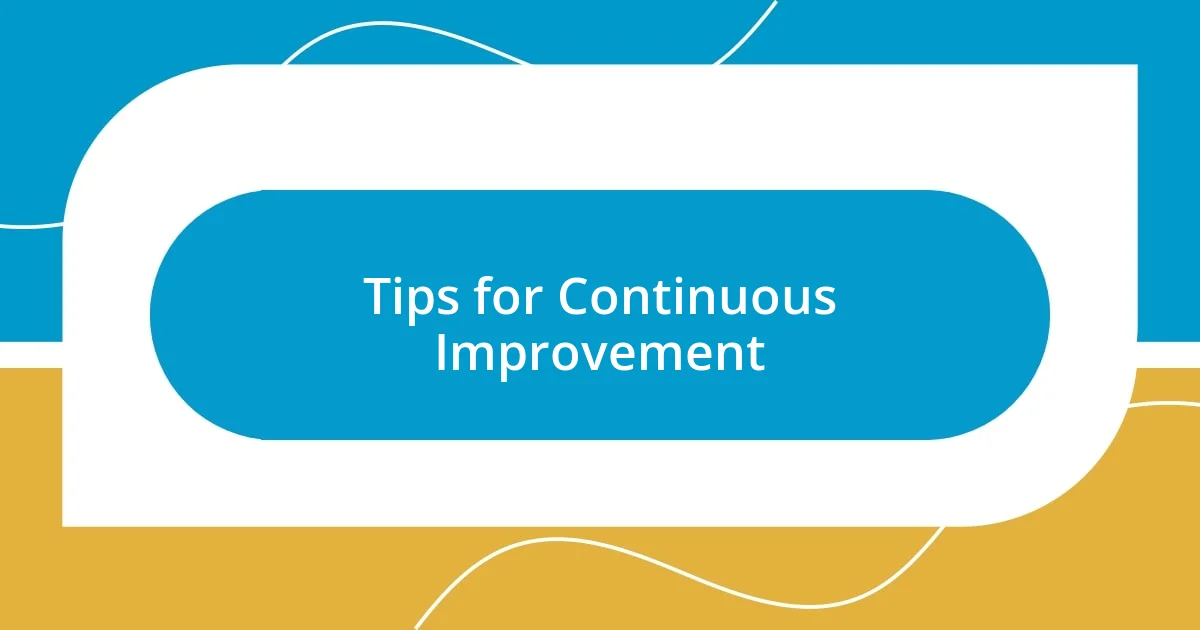
Tips for Continuous Improvement
Continuous improvement requires an open mindset and a willingness to learn. I remember when I started experimenting with different sounds; I took a course that completely changed my perspective. Have you ever found that one resource or person who opened up a new world for you? Seeking knowledge, whether through tutorials or collaborations, can genuinely enhance your skills and creativity.
Another critical tip is to actively seek feedback on your beats. When I started sharing my work, I was hesitant to hear criticism, but I soon realized how valuable it is. One time, a fellow producer suggested subtle changes to my arrangement, and it transformed the whole vibe of the track. Constructive criticism can be uncomfortable, but it’s essential for growth; it helps us see our work from fresh angles and pushes us to refine our craft. How often do you ask for feedback on your projects?
Lastly, track your progress over time. I make it a habit to revisit old beats and note what I would change now, which helps highlight how far I’ve come. Keeping a journal of my creative process allows me to see patterns in my work and identify areas for improvement. This reflection not only fosters a sense of accomplishment but also sparks ideas for future projects. What have you discovered about your evolution as a creator? Embracing this journey is what makes our growth exciting and fulfilling.












